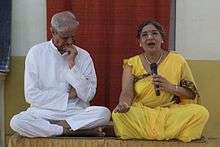The Yoga Institute
Located in Santacruz, Mumbai, The Yoga Institute is known as the oldest organized yoga center in the world.[1] Its founder, Sri Yogendra (1897-1989), played a key role in developing medical hatha yoga,[2] a step in the history of yoga that would later lead to the development of Yoga Therapy.[3][4]
Today the Yoga Institute serves more than a thousand people daily. Yoga courses available include: children, couples, elderly, prenatal, and yoga therapy for health conditions like cardiac problems and hypertension, respiratory problems, diabetes, orthopaedic conditions, and stress related problems. Concentration, relaxation and mind and memory training are also available. These topics are based on the Samkhya principles of the Bhavas, or attitudes which lead to a healthy state.
Yoga teacher training courses are also available over the course of one, three, and seven months. The Institute publishes books on yoga therapy, asanas, pranayam, couples counseling, traditional scriptures, ethics for everyday life, and a variety of other subjects on yoga education.
The Institute is run by Smt. Hansaji Jayadeva Yogendra, who also serves as President of The International Board of Yoga. Hansaji was recently appointed as Special Executive Officer by the Government of Maharashtra on June 20, 2011.
History
The Yoga Institute was founded in 1918 by Shri Yogendraji at “The Sands,” the residence of the Grand Old Man of India, Dadabhai Naoroji, at Versova beach near Bombay. It was the first yoga center to offer courses for free to men, women and children, of any caste or creed. In 1919, Shri Yogendraji set off for America to found The Yoga Institute of America on Bear Mountain, New York. Until his marriage in 1927, Shri Yogendraji toured the world, teaching yoga, treating patients and gathering manuscripts on Hatha Yoga.
The first journal of The Yoga Institute, “YOGA,” was published in 1933 – the pioneering journal continues to be published today.[5] In 1940, publications of the Institute were microfilmed and preserved in the Crypt of Civilization to be read 6000 years later at Oglethorpe University, Georgia.
The Yoga Institute found a permanent base in Santacruz in 1948. In 1951 the Government of India prepared its first cultural documentary film on yoga under its supervision. In that same year, Harvard scientists and UNESCO experts, Dr. Theresa Browne and Dr. JB Millovanovich came to the Yoga Institute to conduct research on the effects of yoni mudra.
In 1957 the Central Government requested the Institute to conduct a survey of yoga in India. The following year, the government recognized the Yoga Institute as a special training institute of yoga and research. Funding was allotted for scholarships for yoga teachers to be trained at the Institute and placed in schools across India. The following decades would see a continuation of research and publication on yoga’s history and its application as medicine.
Yoga Institute launched the Medical Research Unit for research on psychosomatic and psychiatric diseases in 1970 with aid from The Central Council for Research in Indian Medicine and Homeopathy. Yoga Institute Centers were established in Australia, Brazil, Canada, Finland, France, Italy, Japan, South America, Switzerland, Yugoslavia, and the UK.
In 1989, the founder, Shri Yogendraji, died, leaving the care of the institute to his son, Dr. Jayadeva Yogendra.
The Yoga Institute hosted the World Householder’s Yoga Conference in 1997 which was presided over by His Holiness the Dalai Lama. Throughout the history of the Yoga Institute, scores of books have been published, as well as medical research projects, workshops, health camps and community outreach programs.
The Yogendra family

The Yoga Institute’s founder, Shri Yogendraji is one of the figures responsible for simplifying yoga asanas and bringing yogic technologies to the common householder. He was known to be a lover of poetry and a proponent of eugenics, the "applied science or the bio-social movement which advocates the use of practices aimed at improving the genetic composition of a population", usually referring to human populations. He propagated yoga as a means to encourage conscious evolution.[6]
His eldest son, Dr. Jayadeva Yogendra, (M.A., PhD.) took up the Directorship of The Yoga Institute, Santacruz in 1985. He pioneered work in Yoga Education and Therapeutics. His wife, the present Director of the Institute, Smt. Hansaji, has been featured on national television programs for health, a series still running on various international channels. In addition to serving as Director of the institute, Hansaji is also President of The International Board of Yoga
Shri Hrishi Jayadeva Yogendra, son of Dr. Jayadeva and Smt. Hansaji Yogendra is now involved in the administration and management of The Yoga Institute.
The Yoga Institute today
In 2011, the current Director, Smt. Hansaji Jayadeva Yogendra, received an 'Award of Recognition' from the International Association of Yoga Therapists for the Yoga Institute’s contribution to the development of Yoga Therapy. As of 2012, there is a research program being undertaken in collaboration with the Central Health Ministry about stress in mothers of teenagers taking competitive exams. Daily classes and various workshops and programs are still running as of the writing of this entry.
References
External links
- The Yoga Institute Official Website
- Yoga in India Top 24 Yoga Centers in India
- About.com Top 7 Yoga Centers in India
- I Love India
- International Association of Yoga Therapists